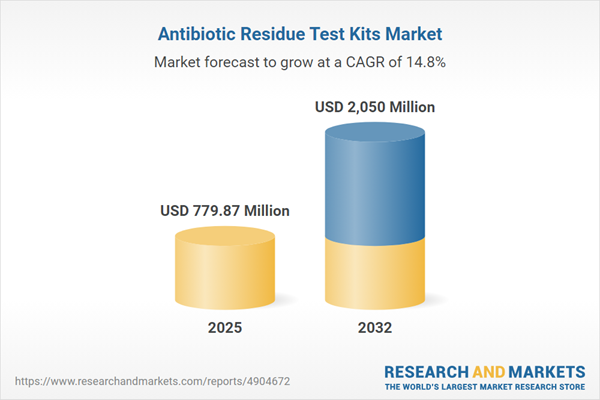Speak directly to the analyst to clarify any post sales queries you may have.
Antibiotic residue test kits are pivotal tools in global food safety management, enabling leaders to navigate stringent regulations while maintaining operational efficiency and product quality across diverse supply chains.
Market Snapshot: Antibiotic Residue Test Kits Market
The antibiotic residue test kits market is valued at USD 680.79 million, demonstrating a compound annual growth rate of 14.80%. Projections indicate the market will reach USD 779.87 million by 2025 and approach USD 2.05 billion by 2032. This substantial expansion is driven by intensified global regulations, technology evolution in diagnostic tools, and widespread uptake in developed and emerging regions. Organizations are increasingly prioritizing harmonized testing standards and automation, streamlining compliance activities, and strengthening oversight as food production chains become more complex and interconnected.
Scope & Segmentation
- Test Types: The market features multiple testing methodologies, including GC-MS, LC-MS, ELISA, and lateral flow devices. These offer both comprehensive laboratory and rapid onsite solutions, ensuring reliable results and efficiency for both routine screening and confirmatory assessments.
- Sample Sources: Kits are designed to monitor various food products—such as aquaculture, eggs, meat, and milk. Targeting critical stages within supply networks, these kits uphold product integrity throughout each phase of sourcing and distribution.
- Animal Origins: Detection options cater to products derived from aquatic species, cattle, poultry, and swine. Tailoring to animal-type helps businesses boost traceability, demonstrating compliance and control in product origins from farm to market.
- End Users: Primary buyers and users include dairy farms, food processors, regulatory agencies, and veterinary laboratories. Each stakeholder leverages these kits for stronger documentation, regulatory adherence, and quality protocols.
- Distribution Pathways: Procurement takes place through offline distributors, e-commerce platforms, and digital sourcing channels. Access to varied supply routes increases flexibility and resilience against evolving market and supply risks.
- Regions: Solutions are customized for compliance across the Americas, Europe, Asia-Pacific, the Middle East, and Africa. Regional adaptation enhances compatibility with both global and local standards in rapidly shifting food safety environments.
- Featured Companies: Key providers such as Neogen Corporation, 3M Company, R-Biopharm AG, Thermo Fisher Scientific Inc., Bio-Rad Laboratories, Charm Sciences, Randox Laboratories, Synbiotics Corporation, Romer Labs, and Merck KGaA collectively influence quality assurance standards and compliance innovation worldwide.
Key Takeaways for Senior Decision-Makers
- Regularly align compliance protocols to reflect frequent changes in international food safety regulations and industry best practices, ensuring transparency at every operational tier.
- Capitalize on advanced diagnostic modalities, including mass spectrometry, to strengthen detection outcomes and facilitate streamlined records management for external audits.
- Adopt rapid assay platforms like ELISA and lateral flow tests to support swift intervention, reducing risk exposure and safeguarding operational momentum.
- Deploy targeted test kits based on animal origin or product type to achieve deeper supply chain traceability in multi-product or cross-regional operations.
- Integrate automated testing and robust data reporting solutions to minimize inconsistencies and drive efficient compliance reporting across distributed sites.
- Prioritize digital and diversified procurement strategies to secure sourcing agility, helping to buffer against disruptions and shifting supplier landscapes.
Tariff Impact: U.S. Market Dynamics in 2025
Recent developments in U.S. tariffs have prompted organizations to assess and realign procurement approaches, with an increased focus on domestic suppliers. This evolution is designed to keep operational costs manageable and compliance systems robust as trade policies fluctuate.
Methodology & Data Sources
This report draws on real-time tracking of regulatory updates, direct interviews with sector specialists, and continuous feedback from top market participants. By leveraging a multi-source approach, the analysis ensures actionable insights for executive teams formulating agile compliance and risk mitigation strategies.
Why This Report Matters
- Empowers leadership to enhance supplier evaluation frameworks and prioritize technology investments aligned to ongoing compliance needs and operational resilience goals.
- Supports robust audit program design and supplier supervision, ensuring alignment with evolving local and global standards.
- Offers benchmarking tools to help management sustain and optimize food safety compliance in highly regulated industry environments.
Conclusion
Acting on the comprehensive recommendations presented empowers senior leaders to elevate compliance strategies, refine procurement processes, and drive technology adoption. Such actions ensure readiness for future food safety and regulatory challenges.
Additional Product Information:
- Purchase of this report includes 1 year online access with quarterly updates.
- This report can be updated on request. Please contact our Customer Experience team using the Ask a Question widget on our website.
Table of Contents
3. Executive Summary
4. Market Overview
7. Cumulative Impact of Artificial Intelligence 2025
Companies Mentioned
The companies profiled in this Antibiotic Residue Test Kits market report include:- Neogen Corporation
- 3M Company
- R-Biopharm AG
- Thermo Fisher Scientific Inc.
- Bio-Rad Laboratories, Inc.
- Charm Sciences, Inc.
- Randox Laboratories Ltd.
- Synbiotics Corporation
- Romer Labs Inc.
- Merck KGaA
Table Information
| Report Attribute | Details |
|---|---|
| No. of Pages | 196 |
| Published | October 2025 |
| Forecast Period | 2025 - 2032 |
| Estimated Market Value ( USD | $ 779.87 Million |
| Forecasted Market Value ( USD | $ 2050 Million |
| Compound Annual Growth Rate | 14.8% |
| Regions Covered | Global |
| No. of Companies Mentioned | 11 |









